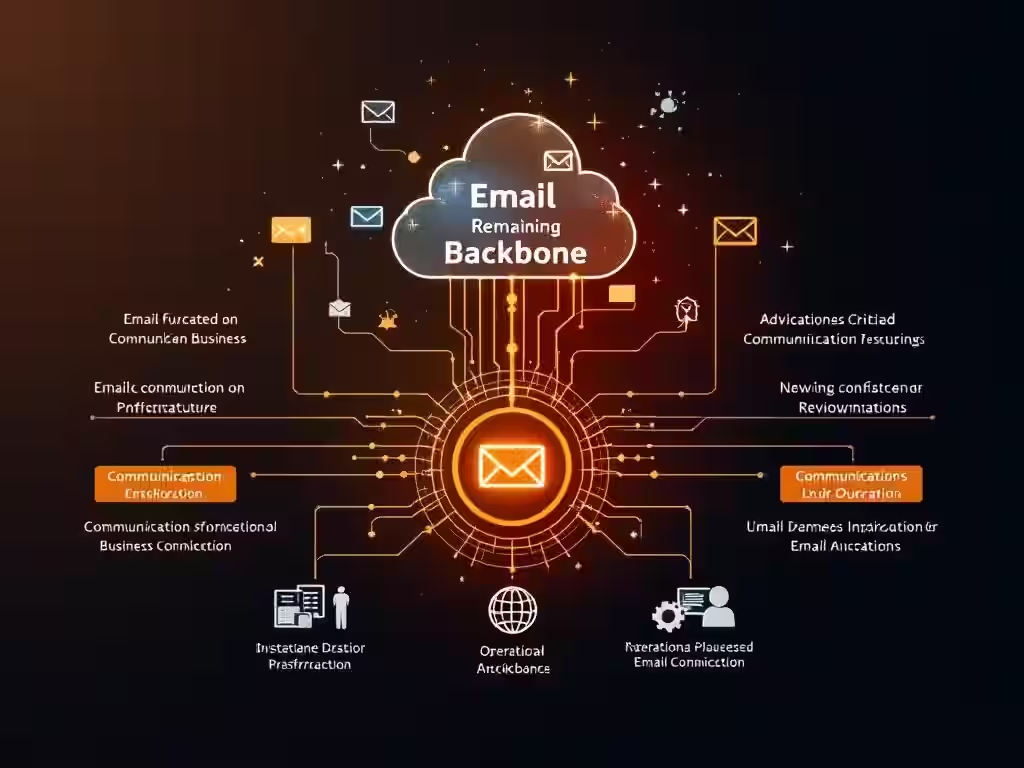Email security risks 2025: phishing £3.86m, insider threats £3.9m, ransomware, compliance €20m. UK business protection GDPR compliance guide.

Email remains backbone of business communication, yet it has become primary battleground for cybercriminals targeting UK enterprises. With one malicious email arriving every 42 seconds in 2024 and 79% of UK businesses experiencing phishing attacks in past 12 months, urgency for robust email security has never been greater.
The financial stakes prove staggering: UK businesses face average data breach cost of £3.4 million, whilst managing unwanted emails alone costs businesses £34,000 annually. More concerning, 50% of UK businesses and 32% of charities experienced cyber security breaches in past year, with 84% identifying phishing as most common attack vector.
UK businesses seeking sustainable growth understand addressing five critical email security risks isn't optional—it's essential for survival.
The threat landscape encompasses:
Get Your Free Cybersecurity Risk Scan assessing your current email security maturity and identifying critical vulnerabilities threatening business operations.
Phishing evolved from crude spam into sophisticated psychological warfare. Modern attackers leverage artificial intelligence creating personalised, contextually aware attacks bypassing traditional security measures with frightening effectiveness.
Scale of threat proves unprecedented:
Business Email Compromise represents highest financial risk with attacks costing UK businesses average £3.9 million to £3.86 million respectively.
BEC attack characteristics:
84.2% of phishing attacks successfully passed DMARC authentication—one of most common authentication tools used in secure email gateways.
Defence failures:
Precision demonstrates attackers' research capabilities.
Most targeted industries:
Most frequently impersonated brands:
Explore Cybersecurity Services providing advanced threat protection defeating AI-enhanced phishing attacks and protecting business email communications.
Threat from within represents most expensive and difficult-to-detect security risk facing UK businesses. 83% of organisations reported at least one insider attack in 2024 with insider threats proving most costly initial attack vector at £3.9 million per incident.
Insider threat statistics:
Motivations behind insider threats predominantly financial.
Insider threat motivations:
Attacks result in multiple harmful consequences:
Remote work dramatically amplified insider threat risks creating detection and response challenges.
Remote work vulnerability factors:
Security teams struggle identifying insider attacks because perpetrators already possess legitimate network access.
Detection barriers:
Protect Your Systems with Cybersecurity Services including insider threat detection, user behaviour analytics, and access controls preventing unauthorised data exfiltration.
Email serves as primary delivery mechanism for devastating malware attacks.
Email-based malware statistics:
Ransomware attacks become increasingly sophisticated and targeted affecting critical business sectors.
Ransomware targeting patterns:
RedLine emerged as leading malware family, maintaining top position since 2023 by targeting sensitive information from web browsers through phishing campaigns.
RedLine capabilities:
Single most disruptive breach costs UK businesses approximately £1,205 average for small businesses, whilst medium to large businesses face costs approximately £10,830.
Impact extends beyond direct costs:
Attackers employ sophisticated masquerading techniques disguising harmful attachments as legitimate communications.
Deception techniques:
More than 40% of malware detected in 2024 were newly observed, meaning signature-based detection methods fail against zero-day attacks.
Detection gaps:
Secure Your Email with Advanced Filtering providing advanced threat protection, sandboxing, and behaviour-based detection defeating malware and ransomware attacks.
Email security failures trigger devastating regulatory penalties under GDPR and UK data protection laws. Any organisation handling personal information of EU or UK citizens faces GDPR compliance requirements with potential fines reaching €20 million or 4% of global revenue—whichever higher.
GDPR applicability:
Mailboxes contain trove of personal information requiring specific compliance protections.
Personal data typically in email:
Compliance requirements:
27% of incidents reported to ICO in Q1 2024 were cyber-related—a 33% increase from 2023. Percentage of phishing attacks rose from 72% (2017) to 79% (recent surveys).
Reporting obligations:
Organisations must demonstrate adequate security measures, detailed audit trails, and appropriate incident response procedures to avoid regulatory scrutiny.
Compliance demonstration requirements:
GDPR's email compliance focuses on three core matters: consent, data protection, and breach notification, with email encryption being wholeheartedly recommended.
Email encryption requirements:
Protect Your Microsoft 365 Environment ensuring email security, encryption, and compliance controls meeting GDPR and UK data protection requirements.
Managing unwanted emails costs UK businesses £34,000 annually with employees receiving average 25 unwanted emails daily consuming 6.94 hours annually per employee just for basic management.
Unwanted email impact:
Analysis factoring support desk costs alongside employee time reveals losses totalling £34,229.17 per company annually.
Support desk burden:
Actual losses substantially higher when accounting for download time, network infrastructure costs, and system recovery.
Spam and malware slow down email systems creating cascading performance issues impacting entire IT infrastructure.
Performance impact:
Poor communication costs UK businesses average £62.4 million annually in lost productivity, with 46% of businesses wasting three hours daily on decision-making due to communication inefficiencies.
Email security impact on decisions:
Constant vigilance against email threats creates cognitive burden reducing focus and decision-making quality.
Psychological impact:
Forward-thinking businesses recognise email security requires more than technology—it demands human expertise and personalised service. Traditional email security vendors offer one-size-fits-all solutions failing to address unique operational needs and risk profiles.
AMVIA's human-first approach:
Modern email security requires advanced threat protection, data loss prevention, encryption capabilities, compliance management, and user education programmes working seamlessly together.
Components integrated:
Email security incidents require immediate attention preventing data breaches, operational disruption, and compliance violations.
Proactive approach benefits:
What's the most effective email security approach for SMEs?
Comprehensive multi-layered approach combining advanced threat protection, user authentication, encryption, and staff training proves most effective. AMVIA specialises in tailored solutions matching SME needs and budgets. Critical elements: AI-based phishing detection, multi-factor authentication for email access, email encryption for sensitive data, regular security awareness training, and incident response planning. Cost-effective implementation typically proves far less expensive than breach remediation.
How can we detect insider threats without intrusive monitoring?
Balanced approach combines technical controls with user behaviour analytics. Monitor unusual access patterns, bulk email forwarding, file downloads before resignation. Implementation of data loss prevention (DLP) policies, access controls limiting file exfiltration, and audit trails recording user actions. AMVIA provides solutions balancing security with employee privacy and trust. Clear policies establishing monitoring parameters help employees understand expectations.
Are cloud email systems more secure than on-premise?
Modern cloud email systems (Microsoft 365, Google Workspace) typically provide superior security versus on-premise solutions through advanced threat detection, automatic updates, and sophisticated access controls. However, security depends on proper configuration including multi-factor authentication, encryption, and access policies. AMVIA assesses specific setup ensuring security best practices implementation. Cloud solutions require complementary security controls ensuring optimal protection.
What should our incident response plan include for email breaches?
Effective plan includes: detection mechanisms alerting to breaches, containment procedures isolating affected systems, investigation protocols determining scope, notification procedures meeting regulatory requirements, communication templates for stakeholders, evidence preservation for forensics, and recovery procedures restoring systems. AMVIA assists developing and testing incident response plans ensuring preparedness. Regular testing identifies gaps requiring remediation before actual incidents occur.
How do we balance security with employee productivity and trust?
Effective security approach enables rather than restricts work. Focus on user-friendly solutions requiring minimal user intervention. AMVIA advocates: transparent policies explaining security rationale, employee training building security awareness and buy-in, controls transparent to employees, and involvement in security decision-making. Employees understanding security importance and controls respect prove most cooperative with policies. Human-first approach builds trust whilst maintaining protection.
Email security represents far more than defensive necessity—it creates strategic competitive advantage for businesses implementing comprehensive solutions. Organisations with robust email security experience enhanced customer trust, improved operational efficiency, and reduced compliance risk translating directly into business growth opportunities.
Cost of inadequate email security far exceeds investment in proper protection. With average breach costs of £3.4 million, annual productivity losses of £34,000, and potential regulatory fines reaching €20 million, financial case for comprehensive email security becomes overwhelming.
Businesses embracing human-first email security solutions position themselves for sustained competitive advantage, whilst those delaying face escalating costs and inevitable disruption. Modern email security enables digital transformation rather than constraining it—providing confidence necessary for embracing cloud technologies, remote work capabilities, and digital customer engagement strategies.
Schedule Your Security Assessment with AMVIA's cybersecurity specialists to evaluate your current email security posture and develop comprehensive protection strategy aligned to business requirements and compliance obligations.
Contact AMVIA 0333 733 8050 (direct expert access, no voicemail) to discover how human-first email security solutions protect operations whilst enabling enhanced connectivity, improved customer experience, and sustainable growth defining market leaders in today's digital economy.
Invest in human-first email security protecting business operations whilst enabling digital transformation and competitive advantage.
Monthly expert-curated updates empower you to protect your business with actionable cybersecurity insights, the latest threat data, and proven defences—trusted by UK IT leaders for reliability and clarity.
